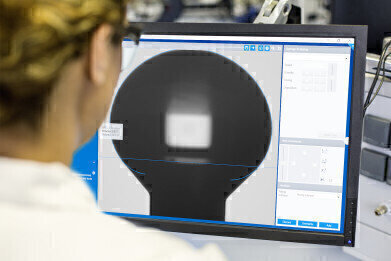-
 Analysis of a Constrained Sessile Drop in the ADVANCE Software.
Analysis of a Constrained Sessile Drop in the ADVANCE Software.
Laboratory Products
New Surface Tension Measuring Method
Apr 21 2022
Single sessile drop reveals surface tension
Krüss has added a versatile method to its portfolio of optical interface analysis with the Constrained Sessile Drop (Constrained SD) technique. Rapid purity checks of contact angle test liquids and analyses of molten materials at high temperatures are the main areas of application.
The method observes how the opposing forces of surface tension (SFT) and gravity affect the shape of a droplet. If the density and dimensions of a dosed sessile drop are known, the SFT can be calculated by image analysis of its contour. For this purpose, the drop must be as large as possible, with a high curvature, while maintaining absolute symmetry. Both are achieved by placing the drop onto a perfectly circular pedestal, whose edges form a wetting barrier - hence the name constrained.
Verify contact angle test liquid purity with no measurement setup change
The Constrained SD extends the range of methods available to Krüss instruments that focus on determining solid material wettability on the basis of contact angles. Test liquids used for contact angle measurements are strongly influenced by even trace amounts of surface-active impurities, such as those left behind by rinsing agents, leading to false results. Checking test liquid SFT using the Constrained SD method provides an effective remedy to this problem. Such measurements are fast, require no change to the measurement setup, and can be seamlessly integrated into daily quality routines. The sample pedestals and associated adapters used in the measurement are available for both laboratory instruments and mobile measuring devices in the Krüss contact angle range.
Measuring surface tension at high temperatures
When it comes to measuring surface tension under standard conditions, classical mechanical tensiometry remains king. However, there are many non-standard cases where the benefits of Constrained SD become obvious. The strengths of the method lie primarily in the analysis of molten materials at high temperatures, for example hot melts whose SFT determines how they wet substrates prior to bonding.
Since a sample can be melted directly on the sample pedestal, no vessels or high-temperature dosing units are required. This, in addition to the small sample volume, prevent the need for time-consuming preparation and cleaning when using Constrained SD. In addition, the method also works well under thermally isolated conditions, which often make measurements in the high-temperature range impossible. The maximum temperature of 400°C can be extended to 2000°C using special sample platforms made of zirconium oxide in combination with a high-temperature measuring system.
Accessories for surface tension measurement using the Constrained Sessile Drop method, and the relevant module of the Krüss software ADVANCE, are now available from the manufacturer.
Digital Edition
Lab Asia 31.2 April 2024
April 2024
In This Edition Chromatography Articles - Approaches to troubleshooting an SPE method for the analysis of oligonucleotides (pt i) - High-precision liquid flow processes demand full fluidic c...
View all digital editions
Events
Apr 28 2024 Montreal, Quebec, Canada
May 05 2024 Seville, Spain
InformEx Zone at CPhl North America
May 07 2024 Pennsylvania, PA, USA
May 14 2024 Oklahoma City, OK, USA
May 15 2024 Birmingham, UK


.jpg)














